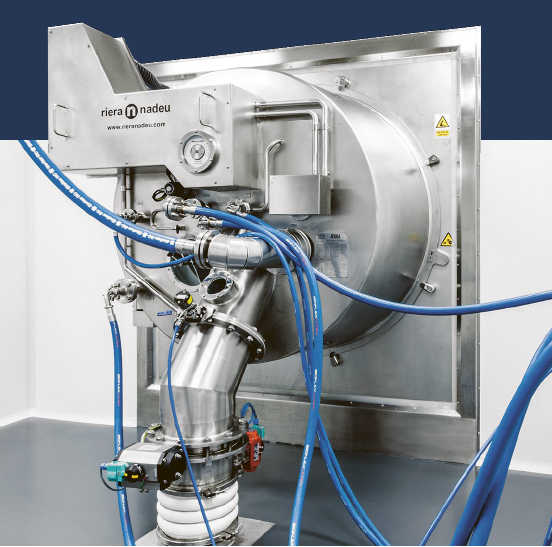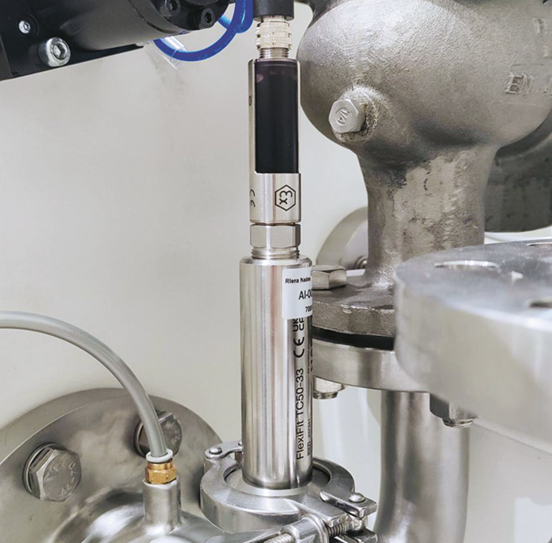RIERA NADEU is a global leader in industrial separation and drying technology, providing high-quality, customizable, and turnkey solutions for the chemical, pharmaceutical, and oil & gas industries (Figure 2). With a strong focus on innovation, the company consistently integrates advanced technologies to enhance both efficiency and reliability.
One of the main challenges in its ATEX-rated centrifuges was the performance of traditional amperometric oxygen sensors, which required frequent maintenance, featured bulky designs, and had relatively short lifespans.
To address these issues, RIERA NADEU adopted Hamilton’s VisiFerm mA Optical Oxygen Sensors. The transition has delivered significant improvements in process reliability and ease of operation.
This article will highlight the benefits and impact of this upgrade within its ATEX (explosive atmosphere) applications.
Point of Measurement
RIERA NADEU had historically utilized amperometric oxygen sensors with separate transmitters from another vendor to monitor oxygen concentration in its ATEX-rated centrifuges’ venting zones (Figure 1).

Figure 1. Centrifuge where the VisiFerm mA was installed. Image Credit: Hamilton Bonaduz AG

Figure 2. Riera Nadeu headquarters. Image Credit: Hamilton Bonaduz AG
These vital applications require ATEX-certified sensor technology that can measure very low levels of oxygen, prompting the company to replace the sensors with Hamilton’s VisiFerm mA optical sensors fitted with the FlexiFit TC 1.5".
This feature helps to streamline sensor integration, removing the external transmitter while maintaining essential 4-20 mA signal compatibility. The VisiFerm mA’s compact design (Figure 3) is key to its simplified installation, allowing RIERA NADEU to effectively resolve sensor placement concerns.
The sensor’s integrated Arc features and Bluetooth capabilities enabled communication with ArcAir software on employees’ mobile devices, streamlining and simplifying sensor maintenance.
Transitioning from a bulky, high-maintenance amperometric system to an integrated, stable optical solution allowed a series of historic limitations to be addressed, including electrolyte replacement and limited lifespans. This move also considerably reduced calibration requirements by eliminating the need for lengthy polarization protocols.
Demanding applications often necessitate the use of a sensor made from a robust and corrosion-resistant material able to withstand corrosive chemicals and acids. Hamilton here, therefore, developed an OEM VisiFerm mA sensor with HASTELLOY. The H4 kit is ideally suited to use in chemical-intensive industries, enhancing sensor lifespan while minimizing maintenance requirements, including reducing calibration frequency.
After its installation, the VisiFerm mA optical sensor ensured consistently accurate oxygen control within RIERA NADEU’s equipment, delivering lasting precision and improved safety in challenging ATEX environments.

Figure 3. Installed VisiFerm mA. Image Credit: Hamilton Bonaduz AG
The adoption of new sensor technology has significantly improved oxygen control and has ultimately led to more efficient, safer, and cost-effective operations, with Hamilton’s OEM expertise also allowing the company to provide RIERA NADEU with application-specific modifications designed to ensure optimal compatibility.
RIERA NADEU now plans to extend its use of VisiFerm mA optical sensors to other equipment, including dryers employed in ATEX environments.
The VisiFerm mA optical sensor from Hamilton can be seamlessly integrated into existing systems, helping companies to lower operational costs and improve measurement accuracy and reliability.
Advantages
- Lower maintenance costs due to the elimination of electrolyte replacement
- Longer lifespan and reduced calibration frequency compared to amperometric sensors
- 360° installation thanks to optical technology
- Greater measurement stability, ensuring precise oxygen control
- More compact and visually attractive design removes the need for external transmitters
- Easy integration with existing systems, demonstrated by maintaining compatibility with the 4-20 mA output signal
- More efficient technical support and shorter delivery times
- More competitive pricing, improving process profitability

Image Credit: Hamilton Bonaduz AG
Acknowledgments
Produced from materials originally authored by David Mansilla (Technical Manager) and Pol Cirera (Marketing Assistant) at Hamilton.
About Hamilton Bonaduz AG
The global Hamilton Group, based in Bonaduz and Domat / Ems, Hamilton Bonaduz AG, Hamilton Medical AG, Hamilton Storage GmbH and Hamilton Ems AG, is one of the technology leaders in life science, storage, measurement and medical technology. The success story is based on the invention of the microliter syringe in the late 1940s by American chemical engineer Clark Hamilton. Today Hamilton produces precision instruments for research and industry as well as intelligent ventilators. In addition, the company is strongly represented in the growth markets of genetics and robotics. Currently, the group employs around 3000 people worldwide, more than 1200 of them in Bonaduz and Domat / Ems. The company is wholly owned by the Hamilton family and has been managed by CEO Andreas Wieland since 2001.
Sponsored Content Policy: News-Medical.net publishes articles and related content that may be derived from sources where we have existing commercial relationships, provided such content adds value to the core editorial ethos of News-Medical.Net which is to educate and inform site visitors interested in medical research, science, medical devices and treatments.